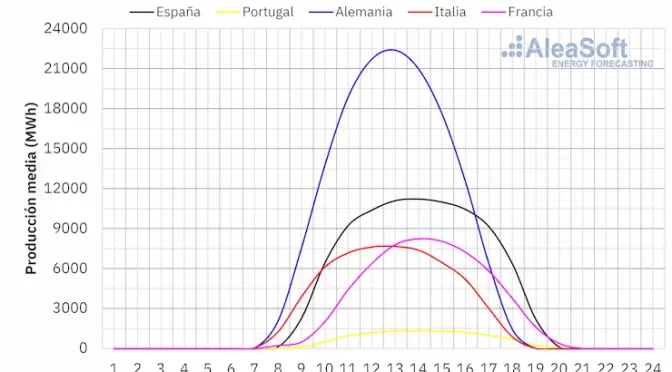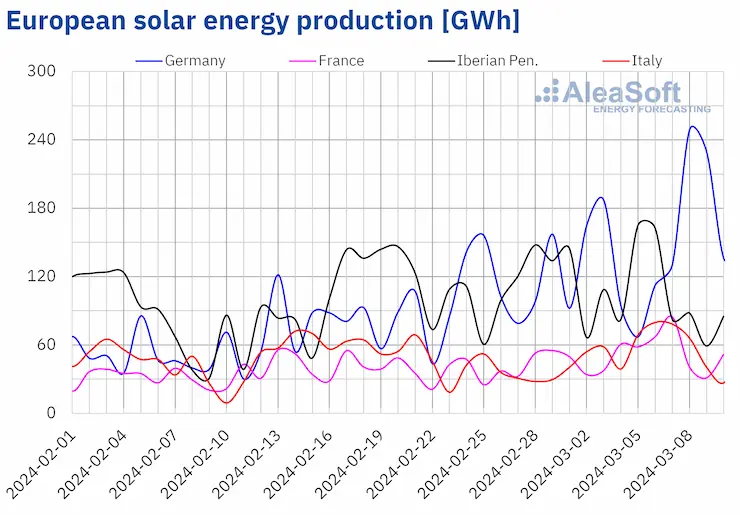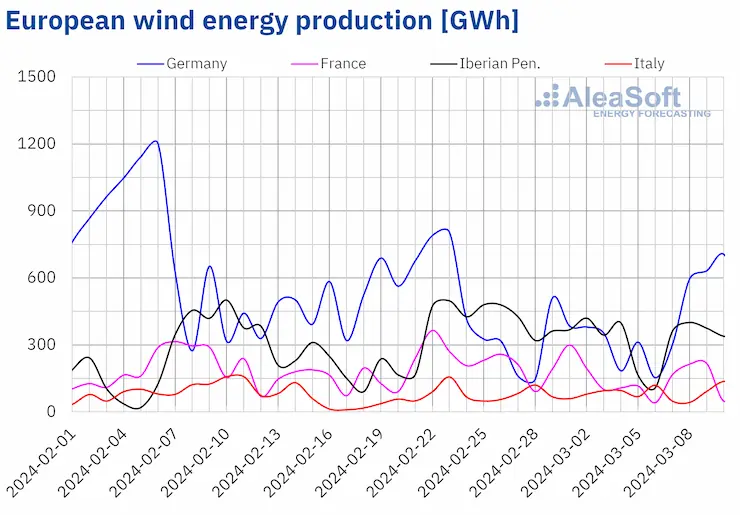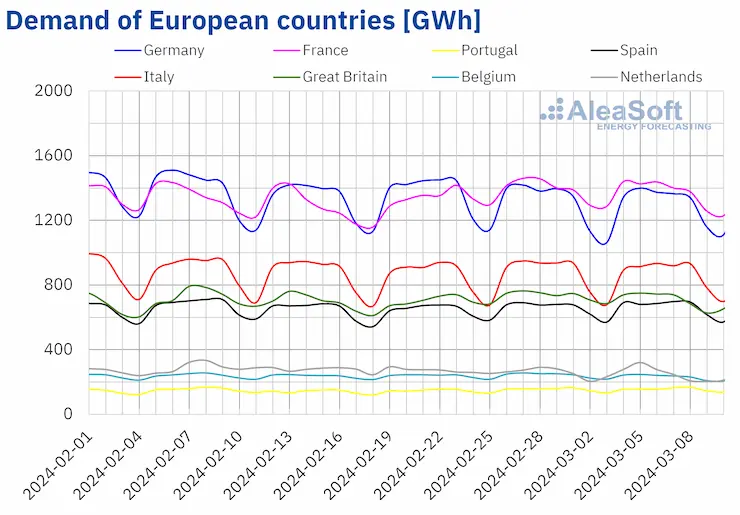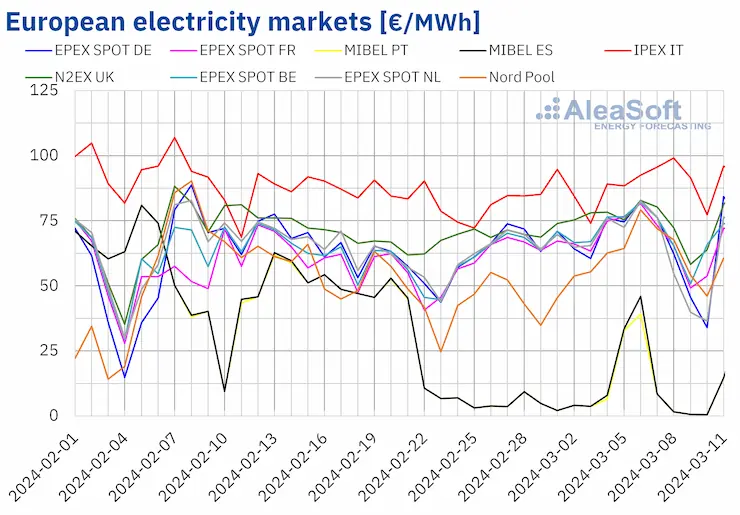In the first week of March, solar photovoltaic energy production reached the highest daily value for a March month in history in most major European electricity markets. This did not prevent weekly average market prices from being higher than in the previous week, supported by higher demand and gas and CO2 prices, as well as lower wind energy production in most markets. The MIBEL market registered the lowest prices again and on Sunday, March 10, it reached the lowest price since February 2014.
Solar photovoltaic, solar thermoelectric and wind energy production
In the week of March 4, solar energy production increased in most major European electricity markets compared to the previous week. The Italian market experienced the largest rise, 44%, reversing the downward trend of the previous two weeks. The German market registered the smallest increase, 16%, rising consistently for the fourth consecutive week. Only the Iberian Peninsula registered a decrease in solar energy production, by 6.5% in Portugal and 12% in Spain.
In most analyzed markets, there were the highest daily photovoltaic energy production levels ever registered for a March month. The list starts with the German market, which produced 249 GWh on March 8, which is also the highest value since mid?September. The Spanish market generated 137 GWh on two days in a row, on March 5 and 6, a level last seen in the summer, on August 31. The French market generated 85 GWh on March 7, which is also the highest value since the end of September. The list is rounded off by Portugal, where solar energy production reached 13 GWh on March 5, slightly below the records registered in February, but still the highest ever registered in a March month.
For the week of March 11, according to AleaSoft Energy Forecasting’s solar energy production forecasts, this week’s upward trend will continue and solar energy production will increase in Germany, Spain and Italy.
Source: Prepared by AleaSoft Energy Forecasting using data from ENTSO-E, RTE, REN, REE and TERNA.
Source: Prepared by AleaSoft Energy Forecasting using data from ENTSO-E, RTE, REN, REE and TERNA.
In the week of March 4, wind energy production decreased in most major European electricity markets compared to the previous week. The French market registered the largest decline, 32%, continuing the trend of the previous week. The Portuguese market registered the smallest decline, 13%, reversing the increases of the previous two weeks. In contrast, wind energy production in Germany increased by 28%. The Italian market followed a similar trend for the third consecutive week, this time with a 7.6% increase.
For the week of March 11, AleaSoft Energy Forecasting’s wind energy production forecasts indicate that the downward trend will continue in the Iberian Peninsula and France. Italy will also register a decrease in wind energy production, reversing the upward trend of recent weeks. Only Germany will register increases in wind energy production.
Source: Prepared by AleaSoft Energy Forecasting using data from ENTSO-E, RTE, REN, REE and TERNA.
Electricity demand
In the week of March 4, electricity demand fell in most major European electricity markets on a week?on?week basis, reversing the upward trend of the previous week. Falls ranged from 0.5% in the Italian and German markets to 4.7% in the Belgian market. In the Dutch and German markets, demand fell for the fourth and second consecutive week, respectively. The Iberian Peninsula was the exception to the downward trend observed in the rest of analyzed markets. The Portuguese and Spanish markets registered an increase in demand, for the third consecutive week, of 0.3% and 1.0%, respectively.
In the first week of March, average temperatures decreased between 0.1 °C and 0.7 °C compared to the previous week in most analyzed European markets. Only in Great Britain, Belgium and France average temperatures increased between 0.5 °C and 0.9 °C.
For the week of March 11, according to AleaSoft Energy Forecasting’s demand forecasts, there will be an increase in Germany, Portugal, Great Britain and the Netherlands, reversing in most cases the downward trend of the previous week. In contrast, demand will fall in the French, Spanish, Italian and Belgian markets.
Source: Prepared by AleaSoft Energy Forecasting using data from ENTSO-E, RTE, REN, REE, TERNA, National Grid and ELIA.
European electricity markets
During the week of March 4, average prices of the main European electricity markets continued to increase. The exception was the EPEX SPOT market of Germany and the Netherlands, with falls of 4.1% and 7.0%, respectively. In contrast, the MIBEL market of Spain and Portugal, which had registered declines the previous week, reached the largest percentage price rises, due to the low prices registered in this market, especially in the last week of February. The average of the Portuguese market increased by 183% and that of the Spanish market by 211%, although the weekly averages were €12.81/MWh and €14.10/MWh, respectively. In the rest of the markets analyzed at AleaSoft Energy Forecasting, prices increased between 1.1% in the N2EX market of the United Kingdom and 31% in the Nord Pool market of the Nordic countries.
Despite these increases, in the first week of March, weekly averages remained below €70/MWh in most analyzed European electricity markets. The exceptions were the Belgian market, the British market and the IPEX market of Italy, with averages of €70.44/MWh, €73.03/MWh and €90.51/MWh, respectively. In contrast, the Portuguese and Spanish markets registered the lowest weekly prices again, €12.81/MWh and €14.10/MWh, respectively. In the rest of the analyzed markets, prices ranged from €62.63/MWh in the Dutch market to €67.79/MWh in the French market.
Regarding hourly prices, on March 9 and 10, the German market registered 7 hours with negative prices. The Dutch market also registered 11 hours with negative prices from March 8 to 10. The lowest hourly price, ?€39.79/MWh, was reached in the Dutch market on March 9, from 13:00 to 14:00. This price was the lowest in this market since the first half of August 2023. On the other hand, despite the increase in the weekly average, the combination of high renewable energy production and low demand also led to low prices in the MIBEL market. In this case, from March 8 to 10, there were 38 hours with a price of €0/MWh. In the case of daily prices, on Sunday, March 10, the MIBEL market of Spain and Portugal averaged €0.54/MWh. This price was the lowest since February 2014 in the Iberian market.
During the week of March 4, the increase in the average price of gas and CO2 emission rights led to higher prices in European electricity markets. The decline in wind energy production in most analyzed markets also contributed to this behavior. In the case of the MIBEL market, moreover, solar energy production fell and electricity demand increased. On the other hand, the increase in wind and solar energy production in Germany contributed to lower prices in that market.
AleaSoft Energy Forecasting’s price forecasts indicate that in the second week of March price increases might continue in European electricity markets. The fall in wind energy production in most markets and the increase in demand in some of them will lead to this behavior.
Source: Prepared by AleaSoft Energy Forecasting using data from OMIE, EPEX SPOT, Nord Pool and GME.
Brent, fuels and CO2
In the first week of March, settlement prices of Brent oil futures for the Front?Month in the ICE market remained below $83/bbl. Prices declined to register the weekly minimum settlement price, $82.04/bbl, on Tuesday, March 5. Subsequently, on March 6 and 7, the settlement price was $82.96/bbl, the highest of the week. On Friday, the settlement price dropped again. It was $82.08/bbl, 1.8% lower than on the previous Friday.
In the first week of March, concerns about demand evolution in China exerted a downward influence on Brent oil futures prices. However, instability in the Middle East and production cuts by OPEC+ member countries helped to keep settlement prices above $82/bbl.
As for TTF gas futures in the ICE market for the Front?Month, settlement prices increased to reach their weekly maximum settlement price, €27.47/MWh, on Tuesday, March 5. According to data analyzed at AleaSoft Energy Forecasting, this price was 13% higher than the previous Tuesday and the highest in the last four weeks. In contrast, on Thursday, March 7, these futures registered their weekly minimum settlement price, €25.99/MWh. On Friday, prices recovered and, in the last session of the week, the settlement price was €26.39/MWh, 2.3% higher than the previous Friday.
In the first week of March, supply concerns due to delays in the return to full operation of the Freeport liquefied natural gas export plant exerted an upward influence on TTF gas futures prices. However, high levels of European reserves allowed prices to remain below €28/MWh.
As for CO2 emission rights futures in the EEX market for the reference contract of December 2024, the upward trend started at the end of the previous week continued until Tuesday, March 5. On that day, these futures registered their weekly maximum settlement price, €60.54/t. According to data analyzed at AleaSoft Energy Forecasting, this was the only occasion when settlement prices exceeded €60/t in the last four weeks. In the rest of the sessions of the first week of March, prices declined. As a result, on Friday, March 8, the settlement price was €58.39/t, still 3.6% higher than the previous Friday’s price.
Source: Prepared by AleaSoft Energy Forecasting using data from ICE and EEX.
AleaSoft Energy Forecasting’s analysis on the prospects for energy markets in Europe and the financing and valuation of renewable energy projects
Next Thursday, March 14, AleaSoft Energy Forecasting and AleaGreen will hold their third webinar of 2024, the year of the 25th anniversary of the foundation of AleaSoft Energy Forecasting. On this occasion, guest speakers from EY will participate for the fourth time in the monthly webinar series. The webinar will analyze the prospects for European energy markets, regulation, financing of renewable energy projects, PPA, self?consumption, portfolio valuation, the green hydrogen auction and the Innovation fund.
